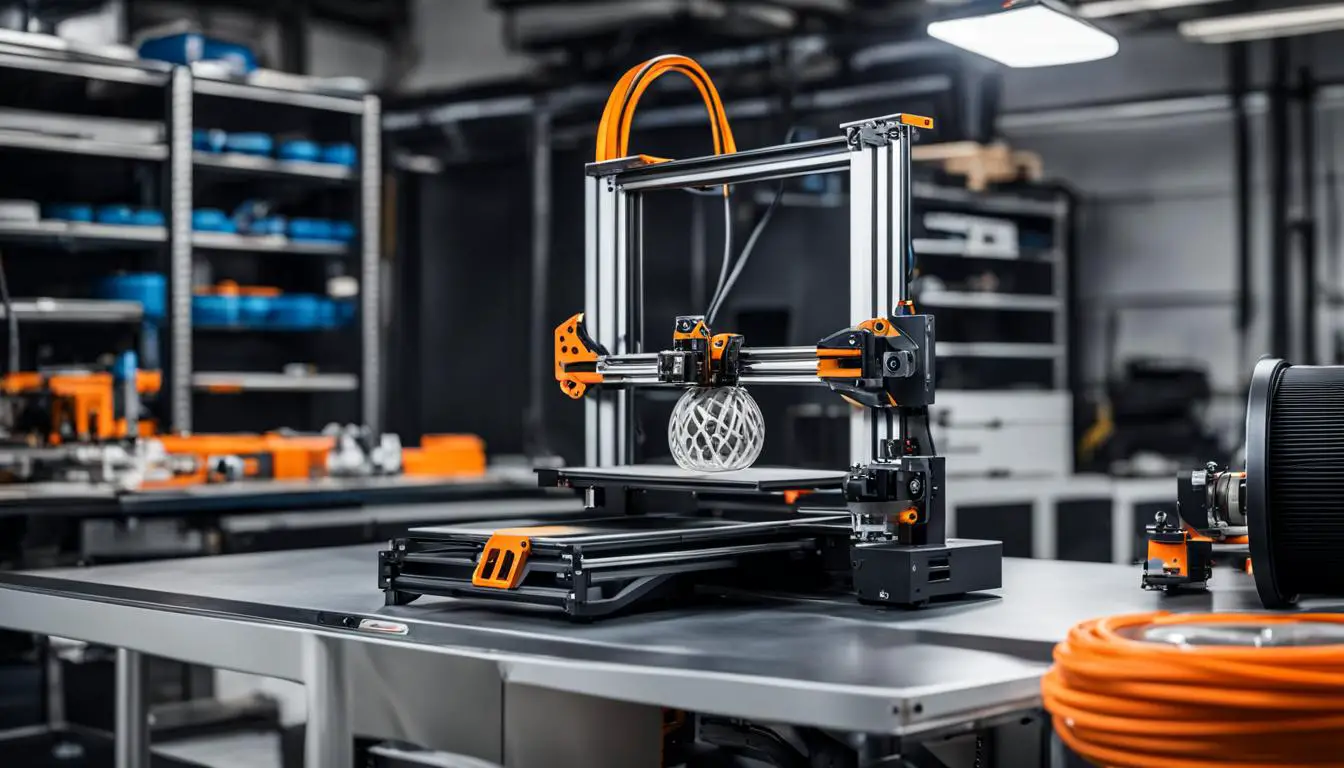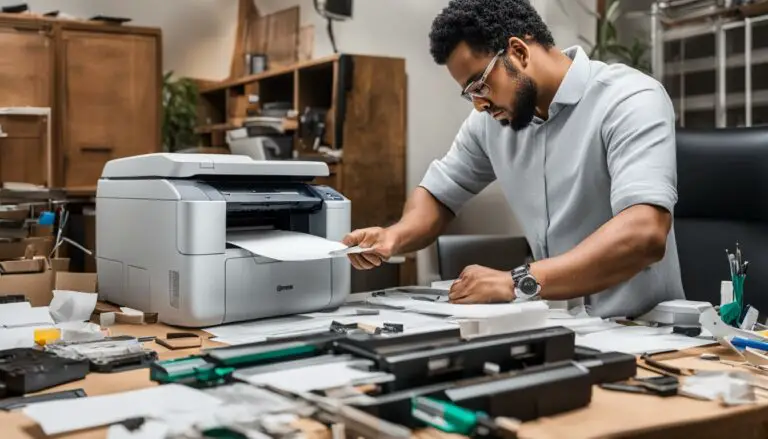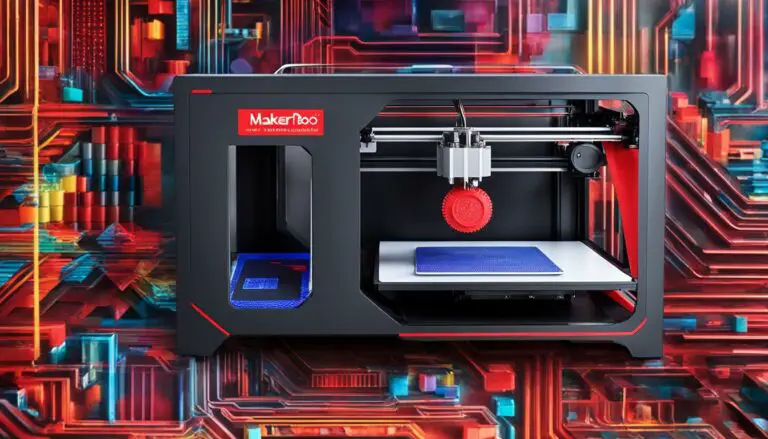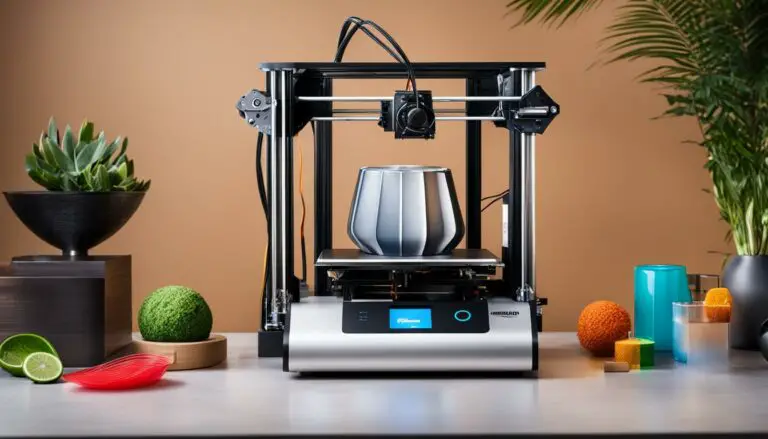Discover Quality 3D Printers for Car Parts: Revolutionize Your Garage!
Originally posted on November 17, 2023 @ 1:32 pm
3D printing has become an essential component in the advancement of automobiles. It provides numerous advantages in the automotive sector, spanning from conceptualization to production.
Prototyping is one of the most common uses of 3D printing in this industry, allowing automotive designers to quickly fabricate prototypes of physical parts or assemblies. With the advancements in 3D printing technology, companies can now create highly convincing, representative, and functional prototypes within a day, at a much lower cost than traditional manufacturing methods. This enables faster iteration cycles and shortens the time between idea and final product.
Key Takeaways:
- 3D printing revolutionizes the automotive industry from design to manufacturing.
- Prototyping with 3D printing allows for faster iteration cycles and cost savings.
- Advancements in 3D printing technology have made it possible to create highly functional prototypes within a day.
- Automotive manufacturers can now produce complex, customized parts at a lower cost.
- 3D printing enables faster time-to-market and opens up new possibilities for design and production in the automotive industry.
How 3D Printing Revolutionizes Automotive Part Manufacturing
Additive manufacturing using 3D printers is revolutionizing automotive part manufacturing. The ability to produce complex, custom parts quickly and cost-effectively is a key advantage of 3D printing in this industry. It allows for the production of high-precision, functional 3D prints that can be used as final parts, offering customization opportunities and high performance. 3D printing also enables the creation of lightweight, high-strength parts with complex internal geometries that would be difficult to achieve with traditional manufacturing methods. This technology is playing an increasingly important role in the automotive industry, offering manufacturers the ability to improve efficiency, reduce costs, and create innovative designs.
One of the key benefits of 3D printing in automotive part manufacturing is the ability to create highly customized parts. Traditional manufacturing methods often have limitations when it comes to producing complex shapes and designs. With 3D printing, automotive manufacturers can easily produce parts with intricate geometries and unique features, giving them a competitive edge in the market. These customized parts can also improve performance by reducing weight and increasing efficiency.
In addition to customization, 3D printing also offers significant time and cost savings. Traditional manufacturing processes often involve multiple steps and expensive tooling, which can be time-consuming and costly. 3D printing eliminates the need for tooling and allows for direct production of parts, reducing lead times and costs. It also enables manufacturers to produce small batches of parts on demand, eliminating the need for large inventory and storage space. This flexibility and efficiency make 3D printing a valuable tool in automotive part manufacturing.
Table: Comparison of 3D Printing and Traditional Manufacturing Methods
| Aspect | 3D Printing | Traditional Manufacturing |
|---|---|---|
| Speed | Fast prototyping and production | Longer lead times |
| Complexity | Can produce complex geometries | Limitations in design complexity |
| Cost | Lower tooling and material costs | Higher tooling and material costs |
| Customization | Highly customizable parts | Limited customization options |
As the automotive industry continues to evolve, the use of 3D printing in part manufacturing will only become more prevalent. Manufacturers are embracing this technology to gain a competitive edge, improve efficiency, and create innovative designs. With its ability to produce custom, high-precision parts quickly and cost-effectively, 3D printing is revolutionizing the way automotive parts are manufactured.
Advancements in 3D Printing Technology
The rapid development of 3D printers and high-performance materials has significantly advanced additive manufacturing in the automotive industry. Automotive manufacturers are leveraging the latest 3D printing technologies to enhance prototyping and production processes, resulting in improved efficiency, cost savings, and innovative designs.
The use of Formlabs 3D printers has allowed us to experiment with different lighting conditions for the lettering on the back of the Ford Puma. This technology has greatly facilitated the design process and has enabled us to rapidly prototype and iterate on various concepts.”
– Ford designer
Companies like Ford have adopted Formlabs 3D printers for prototyping purposes, enabling designers to quickly test and refine different design elements. In addition, industrial design studios and manufacturers, such as IGESTEK, are utilizing large-format 3D printers like the Form 3L to simultaneously prototype multiple designs and create lightweight, high-strength parts.
These advancements in 3D printing technology have empowered automotive manufacturers to produce parts that can withstand extreme environments while offering increased efficiency and customization potential. As the automotive industry continues to embrace these technological advancements, we can expect to see further progress and applications in the near future.
| Benefits of Advancements in 3D Printing Technology: |
|---|
| 1. Faster prototyping and iteration cycles |
| 2. Cost savings compared to traditional manufacturing methods |
| 3. Creation of highly functional and representative prototypes |
| 4. Ability to produce lightweight, high-strength parts with complex geometries |
| 5. Improved efficiency and customization potential |
With ongoing advancements in 3D printing technology, the automotive industry is experiencing a transformative shift in how car parts are designed, prototyped, and manufactured. By leveraging these technologies, manufacturers can optimize their production processes, reduce costs, and stay at the forefront of automotive innovation.
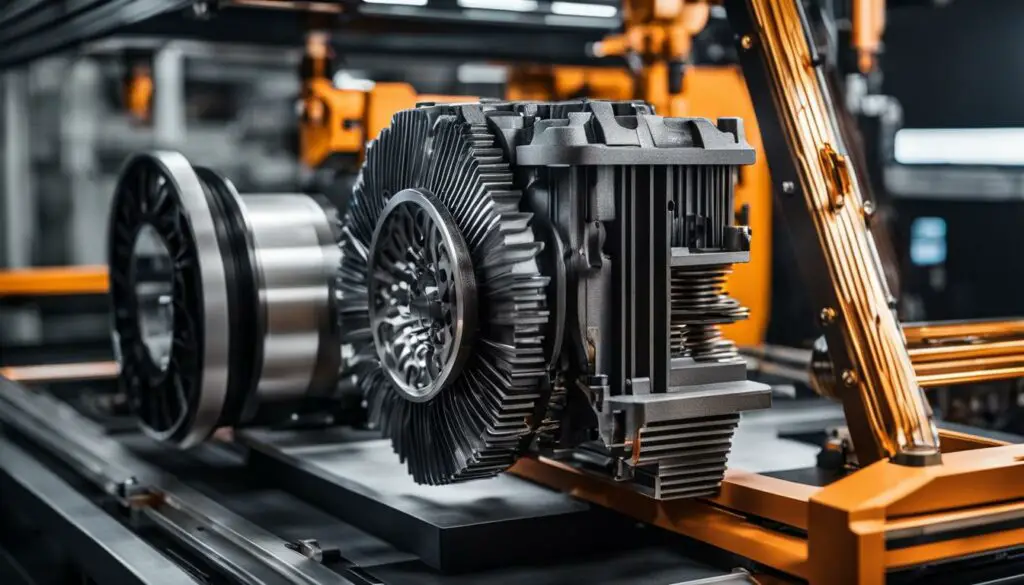
3D Printed Parts in Automotive Manufacturing
3D printing technology is revolutionizing car part production in the automotive industry. With its ability to create custom jigs, fixtures, and low-volume rapid tooling, manufacturers can improve efficiency and reduce costs in traditional manufacturing processes like injection molding or thermoforming. One company leading the way in this field is Makra Pro. They have developed novel techniques for molding materials like leather using 3D printed dies, allowing for the creation of complex shapes and designs that would be difficult to achieve with traditional methods.
With 3D printing, automotive manufacturers can also produce aftermarket, custom, or replacement parts more efficiently. This not only reduces overhead but also opens up new possibilities for design and production. Cutting-edge 3D printers specifically tailored for automotive applications are being developed to meet the industry’s unique needs. These printers offer higher precision, faster printing speeds, and the ability to work with a variety of materials, including high-performance polymers and composites.
| Benefits of 3D Printed Parts in Automotive Manufacturing | Examples |
|---|---|
| Cost savings | Using 3D printing for low-volume production of custom parts reduces the need for expensive tooling and molds. |
| Customization | 3D printing allows for the creation of unique, one-of-a-kind parts tailored to specific customer requirements. |
| Speed and efficiency | With 3D printing, complex parts can be produced quickly, reducing lead times and improving overall production efficiency. |
| Design freedom | 3D printing enables the creation of intricate, lightweight designs with complex geometries that would be difficult to achieve with traditional manufacturing methods. |
As the technology continues to evolve, we can expect to see even more advancements and applications in the automotive industry. 3D printing is transforming the way car parts are manufactured, offering innovative solutions and pushing the boundaries of design and production. By embracing this cutting-edge technology, automotive manufacturers can stay ahead of the competition and meet the ever-changing demands of the industry.
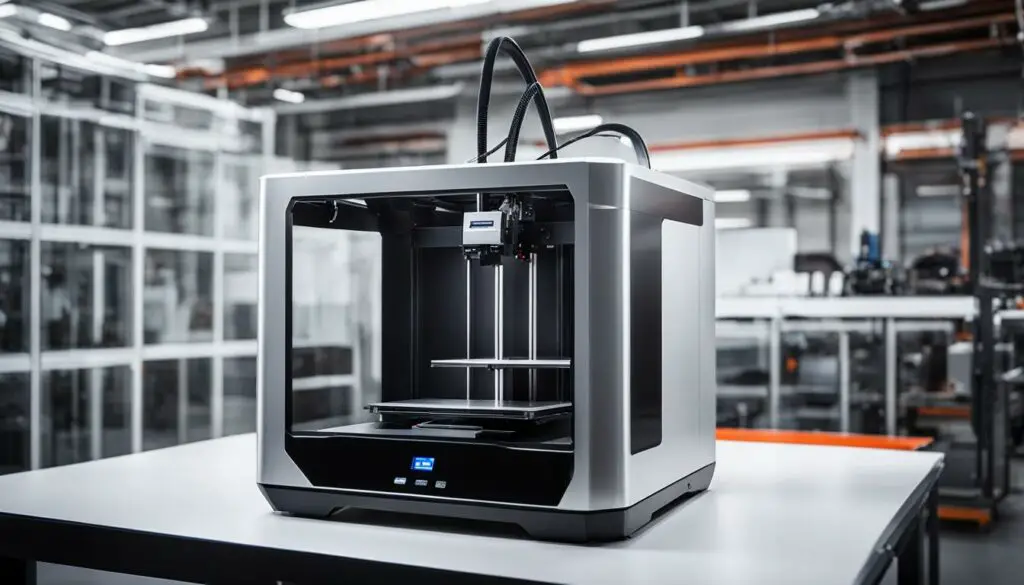
Successful Case Studies in Automotive Manufacturing
When it comes to revolutionizing car part production, 3D printing has already made a significant impact in the automotive industry. Let’s take a look at some successful case studies that highlight the transformative power of this technology.
Case Study 1: Vital Auto
Vital Auto, an industrial design studio based in the UK, has embraced 3D printing to create prototypes and concept models for major car brands. By leveraging the capabilities of 3D printing, they are able to accelerate their product development process, resulting in better products and faster time to market. The use of cutting-edge materials and the ability to create complex designs has also attracted new business from customers who value the latest technologies in automotive design.
Case Study 2: Team Penske
Team Penske, a leading motorsports team, has integrated stereolithography 3D printers into their manufacturing workflow. This has allowed them to achieve superior surface finish, increase throughput, and enhance reliability in producing car parts. By adopting 3D printing technology, Team Penske has gained a competitive edge in the fast-paced world of motorsports, where precision and speed are crucial.
These case studies demonstrate how 3D printing is revolutionizing car part production in the automotive industry. From improving product development cycles to providing innovative solutions, 3D printing offers manufacturers the ability to stay ahead of the competition. As the technology continues to evolve, we can expect to see even more advancements and applications in automotive manufacturing.
| Case Study | Key Benefits |
|---|---|
| Vital Auto | – Faster product development – Access to cutting-edge materials – Attracting new business opportunities |
| Team Penske | – Superior surface finish – Increased throughput – Enhanced reliability |
These case studies showcase the real-world impact of 3D printing in the automotive industry, highlighting how it has revolutionized car part production and empowered manufacturers to push the boundaries of design and performance.
Conclusion
3D printing is revolutionizing car part production in the automotive industry. From prototyping to manufacturing, this technology offers numerous benefits, including faster iteration cycles, cost savings, and the ability to create complex, customized parts.
The advancements in 3D printing technology, along with the use of high-performance materials, have made it possible to produce high-precision, functional parts that can withstand extreme environments. Automotive manufacturers are embracing 3D printing to improve efficiency, reduce costs, and create innovative designs. As the technology continues to evolve, we can expect to see even more advancements and applications in the automotive industry.
With the ability to produce highly convincing, representative, and functional prototypes within a day, 3D printing shortens the time between idea and final product. It enables automotive designers to quickly fabricate prototypes of physical parts or assemblies, allowing for faster development and evaluation of designs.
Overall, 3D printing is transforming car part production. Its versatility, cost-effectiveness, and customization potential are revolutionizing the automotive industry. As more companies adopt this technology, we can anticipate further advancements and innovations that will continue to shape the future of car manufacturing.
FAQ
What are the benefits of using 3D printing in the automotive industry?
3D printing offers faster iteration cycles, cost savings, and the ability to create complex, customized parts.
How does 3D printing revolutionize automotive part manufacturing?
3D printing allows for the production of high-precision, functional 3D prints that can be used as final parts, offering customization opportunities and high performance.
What advancements have been made in 3D printing technology for car parts?
Advancements in 3D printing technology have enabled automotive manufacturers to produce parts that can withstand extreme environments and have improved efficiency and customization potential.
How are 3D printed parts used in automotive manufacturing?
3D printed parts are used for aftermarket, custom, or replacement parts, as well as for creating jigs, fixtures, and low-volume rapid tooling for traditional manufacturing processes.
Are there any successful case studies of 3D printing in automotive manufacturing?
Yes, there have been successful case studies where 3D printing has helped automotive manufacturers create better products faster and stay ahead of the competition.
How is 3D printing revolutionizing car part production?
3D printing is transforming automotive manufacturing by offering innovative solutions and opening up new possibilities for design and production.

